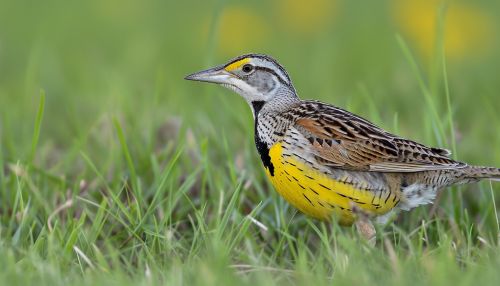Eastern Meadowlark
Description
The Eastern Meadowlark (Sturnella magna) is a medium-sized icterid bird, native to eastern North America. Known for its distinctive, flute-like song, the Eastern Meadowlark is predominantly a ground-dwelling bird that prefers grasslands and agricultural areas.


Taxonomy and Systematics
The Eastern Meadowlark is one of seven species in the genus Sturnella, and is a member of the family Icteridae, which also includes blackbirds, orioles, and grackles. The species was first described by Carl Linnaeus in his 18th-century work, Systema Naturae. The scientific name Sturnella magna translates to "great little starling", a reference to its starling-like appearance and larger size compared to other members of the genus.
Physical Characteristics
Eastern Meadowlarks are notable for their sturdy bodies, long, pointed bills, and relatively short tails. They measure between 8.5 and 11 inches in length, with a wingspan ranging from 13.5 to 16 inches. The adult bird's weight can vary from 3.2 to 4.7 ounces.
The bird's plumage is predominantly brown with black streaks on the back and wings, while the underparts are bright yellow with a distinctive black V-shaped band across the chest. The tail is mainly white with a dark center, and the legs and feet are pinkish-brown. Both males and females have similar coloration, although males tend to be slightly larger.
Distribution and Habitat
Eastern Meadowlarks are found across a broad range in North America, from eastern North Dakota to Texas and east to the Atlantic coast. They are also present in parts of Central America and the Caribbean.
The species prefers open country with grassy fields, pastures, and meadows, as well as agricultural land. They are less common in heavily forested or urban areas. Eastern Meadowlarks are largely sedentary, although northern populations may migrate southwards during the winter months.
Behavior and Ecology
Eastern Meadowlarks are primarily ground feeders, foraging for a variety of foods including insects, seeds, and berries. They use their strong bills to probe the soil for invertebrates, particularly during the breeding season when protein-rich food is essential for chick development.
Mating occurs in the spring and early summer, with males establishing territories and attracting females through song. Females build a nest on the ground, often concealed by grass or other vegetation. The clutch size typically ranges from 3 to 5 eggs, which are incubated by the female for about two weeks.
Eastern Meadowlarks are known for their distinctive, melodic song, which is often described as a clear, whistled "see-you, see-ya" or "spring of the year". Males sing from elevated perches to establish territories and attract mates.
Conservation Status
The Eastern Meadowlark is currently classified as a species of Least Concern by the IUCN. However, the population has been declining due to habitat loss and degradation, particularly the conversion of grasslands to agricultural use. Conservation efforts are focused on preserving and restoring suitable habitat, as well as promoting sustainable farming practices.
